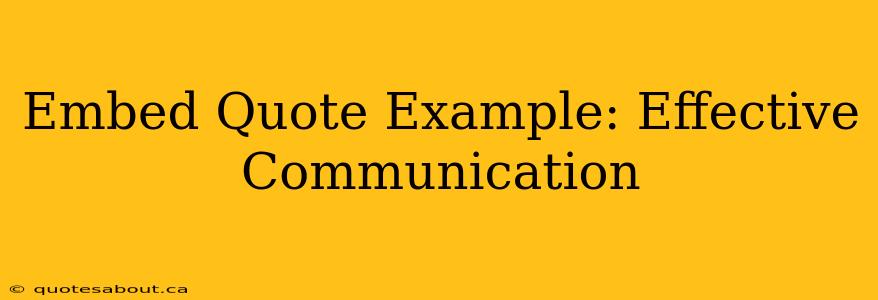Effective communication is the cornerstone of successful relationships, both personal and professional. It's the bridge that connects ideas, fosters understanding, and drives progress. But what makes communication truly effective? It's more than just speaking or writing; it's about conveying your message clearly, concisely, and in a way that resonates with your audience. This often involves understanding your audience, choosing the right medium, and being mindful of your nonverbal cues. Let's delve deeper into this crucial skill.
What are the Key Elements of Effective Communication?
Effective communication isn't a one-size-fits-all approach. It's a dynamic process that requires adaptability and awareness. Several key elements contribute to its success:
- Clarity: Your message should be easy to understand. Avoid jargon, ambiguity, and overly complex sentence structures. Get straight to the point.
- Conciseness: Respect your audience's time. Deliver your message efficiently, eliminating unnecessary words or details.
- Empathy: Put yourself in your audience's shoes. Consider their perspective, knowledge, and emotional state. Tailor your message accordingly.
- Active Listening: Effective communication is a two-way street. Pay close attention to what others are saying, both verbally and nonverbally. Ask clarifying questions and show that you're engaged.
- Nonverbal Communication: Your body language, tone of voice, and facial expressions speak volumes. Ensure these elements align with your verbal message to avoid confusion.
- Choosing the Right Medium: The method you choose to communicate (email, phone call, face-to-face meeting) should align with the context and importance of the message.
How to Embed Quotes for Effective Communication
Embedding quotes strategically can significantly enhance your communication. They add credibility, provide context, and make your message more memorable. However, it's crucial to do it effectively:
- Choose Relevant Quotes: Select quotes that directly support your point and resonate with your audience. Avoid using quotes simply for the sake of it.
- Provide Context: Before introducing a quote, set the stage by explaining its relevance and the source. This prevents misinterpretations and ensures a smooth flow.
- Proper Attribution: Always cite the source of the quote accurately. This builds credibility and avoids plagiarism. Use quotation marks to clearly indicate the quoted text.
- Integrate Seamlessly: Don't just drop a quote in; weave it naturally into your text. Explain how the quote supports your argument and connect it to the surrounding information.
Example:
Let's say you're writing about the importance of active listening. You could embed a quote like this:
"The most basic of all human needs is the need to understand and be understood." – Ralph Nichols
"This quote by communication expert Ralph Nichols highlights the fundamental importance of active listening. By truly understanding others, we build stronger relationships and foster more effective communication."
What are Some Common Barriers to Effective Communication?
Several obstacles can hinder effective communication:
- Noise: This refers to any interference that disrupts the transmission of a message – physical noise (loud sounds), psychological noise (preconceived notions), or semantic noise (differences in interpretation).
- Lack of Clarity: Ambiguous language, jargon, or insufficient detail can lead to misunderstandings.
- Emotional Barriers: Strong emotions (anger, fear, anxiety) can cloud judgment and impede clear communication.
- Cultural Differences: Different cultures have varying communication styles, leading to potential misunderstandings if not considered.
How Can I Improve My Communication Skills?
Improving your communication skills is an ongoing process. Here are some helpful tips:
- Practice Active Listening: Pay attention, ask clarifying questions, and summarize to ensure understanding.
- Seek Feedback: Ask others for their honest opinions on your communication style.
- Take Courses or Workshops: Formal training can provide valuable insights and techniques.
- Read Widely: Expand your vocabulary and learn from different writing styles.
- Be Mindful of Nonverbal Cues: Pay attention to your own body language and that of others.
By understanding and applying these principles, you can significantly improve your communication effectiveness, leading to stronger relationships and greater success in all areas of your life. Remember, effective communication is a skill that's refined through practice and conscious effort.

